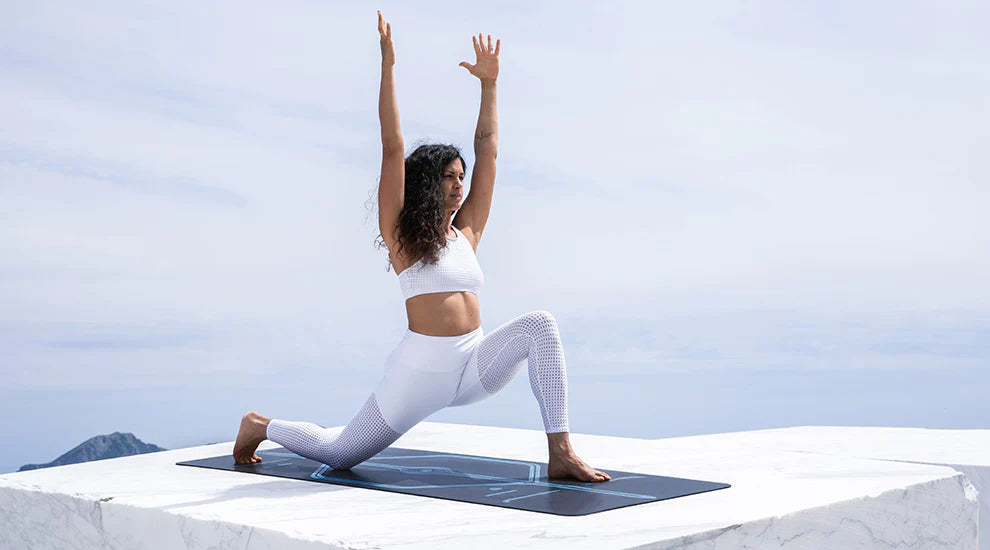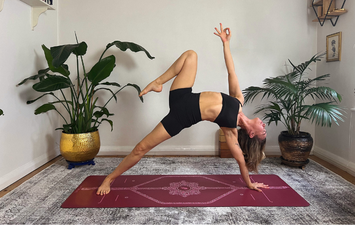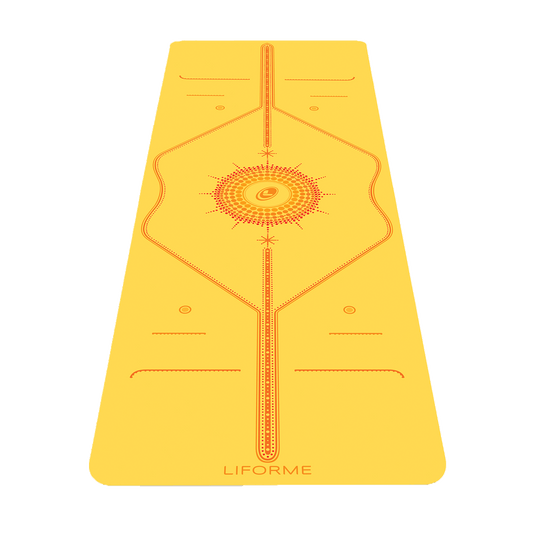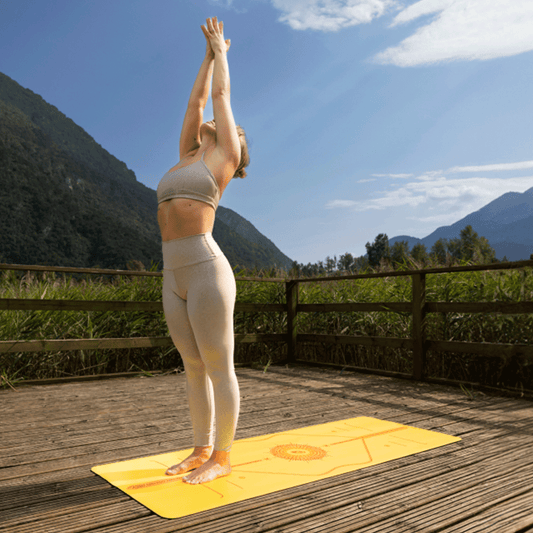Yes, that’s right, yoga is a wonderful addition to any runner’s training regimen. Running is a very repetitive motion, so it’s useful to mix things with practices that encourage your whole body to move in entirely different ways. Stretching is essential for all athletes, but yoga is unique in the ways that it accesses and strengthens the small muscles that support your joints, not just the major muscles.
Yoga Poses Before Running
When stretching before a run, go gently. Prepare your legs for activity by including poses that loosen your quads, hips, groins, and hamstrings.

Downward Facing Dog Pose (Adho Mukha Svanasana)
Benefits: It’s a classic for a reason!
Stretches your whole body. Calves, hamstrings, back, shoulders, it’s all there.
Yoga Level: Beginner
Step-by-Step:
1. Come to a hands-and-knees position.
2. Curl your toes under and press into your palms to lift your butt toward the ceiling and straighten your legs.
3. Keep pressing into your palms.
4. Peddle your feet a few times to warm up the backs of your legs.

Low Cobra Pose (Bhujangasana)
Sanskrit Meaning: Bhujanga (Cobra)
Yoga Level: Beginner
Benefits: Warms your back muscles and activates your core for greater stability and injury prevention.
Step-by-Step:
1. Lie down on your stomach with your palms under your shoulder and your elbows pointing alongside your body.
2. Press into your pelvis and the tops of your feet to lift your chest away from the floor. Do not press into your palms.
3. Repeat at least three times, lifting on your inhalations.

Standing Quad Stretch
Yoga Level: Beginner
Benefits: Maybe not technically a yoga pose, but a vital part of a running warm-up. Standing on one leg at a time also improves your balance and core strength.
Step-by-Step:
1. Begin in Mountain Pose.
2. Take your weight into your left leg without changing the position of your pelvis.
3. Bend your right knee and lift your right heel toward your right buttock.
4. Keep your knees in line with each other.
5. Hold your right foot with your right hand.
6. Gently pull your right foot closer.

Crescent Lunge Pose (Anjaneyasana)
Sanskrit Meaning: Anjani (Hindu Goddess)
Yoga Level: Beginner
Benefits: Now it’s time to stretch your hip flexors and groin.
Step-by-Step:
1. Come into a low lunge with your left foot at the front of your mat and your right knee on the floor.
2. Keep your hands on the floor for this version.
3. You can bend deeply in your front knee or keep it over your ankle if that’s a better fit.
4. Try a Yoga Pad under your back knee for more support.
5. Do both sides.

One-Legged Chair Pose (Eka Pada Utkatasana)
Sanskrit Meaning: Eka (One) Pada (Foot) Utkata (Powerful)
Yoga Level: Intermediate
Benefits: Stretch the outer thighs and fire up your glutes at the same time. Back up to a wall if you feel wobbly.
Step-by-Step:
1. Begin in Chair Pose.
2. Without changing the position of your hips, take your weight into your left leg and lift your right foot off the floor.
3. Cross your right ankle over your left thigh.
4. Release your right knee toward the floor.
5. Repeat on the other side.

Side Lunge Pose (Skandasana)
Sanskrit Meaning: Skanda (Hindu War Deity)
Yoga Level: Intermediate
Benefits: Get in some lateral stretching. You don’t need to go into the full pose if that seems like a lot. You can take a wide stance and alternately bend each knee instead.
Step-by-Step:
1. Take your legs wide apart with the feet parallel.
2. Bend your left knee.
3. If you want to go deeper, turn your left toes out 45 degrees and squat toward the floor while keeping your right leg straight.
4. Your right toes may come away from the mat.
5. Do both sides.
Yoga Poses After Running
After a run, you want to cool down and stretch in a way that promotes recovery. This can be an appropriate time to go a little deeper into the same group of muscles you focused on in your warm-up.

Eye of the Needle Pose (Sucirandhrasana)
Also Known As: Reclined Pigeon Pose
Sanskrit Meaning: Suci (Needle) Randra (Opening)
Yoga Level: Beginner
Benefits: Reprise the Figure-4 position of Eka Pada Utkatasana (above) while lying on your back. Substitute Pigeon here if you prefer, but Eye of the Needle is gentler and easier to control.
Step-by-Step:
1. Lie on your back with your feet flat on the mat and knees pointing toward the ceiling.
2. Bring your left ankle across your body to rest on your right thigh. Your left knee will point to the left.
3. Lift your right foot away from the floor and draw your right thigh toward your body.
4. Reach your right hand around the outside of your right thigh and your left hand through the space between your legs to hold onto your shin or the back of your right thigh.
5. Gently pull your right thigh closer.
6. Repeat on the other side.

Head-to-Knee Pose (Janu Sirsasana)
Sanskrit Meaning: Janu (Knee) Sirsa (Head)
Yoga Level: Beginner
Benefits: A classic hamstring stretch, yoga style. That means keeping a long spine and using your breath to deepen the pose on each exhalation.
Step-by-Step:
1. Come to sit with your legs outstretched and your spine long. Take a blanket or bolster under your seat if that helps you sit up straight.
2. Bend your right knee and bring the sole of your right foot to the inside of your left thigh.
3. Inhale to lengthen your spine and exhale to forward fold over your left leg.
4. It’s not necessary to reach your foot with your hand. Use a strap or a towel around your foot or take your hands to the mat on either side of your leg.
5. Do both sides.

Supine Spinal Twist (Supta Matsyendrasana)
Sanskrit Meaning: Supta (Supine) Lord of Fishes (Matsyendra)
Yoga Level: Beginner
Benefits: Unwind your spine and get a last stretch in for your hips.
Step-by-Step:
1. Lie on your back with your left leg extended and your right leg bent with your knee pointing toward the ceiling.
2. Extend your right arm to the right.
3. Bring your right knee across your body toward the mat to the left on your left leg.
4. Keep your right shoulder on the floor. That may mean your right knee doesn’t come all the way to the floor. It can hover it or you can take a block or a blanket under it for support.
5. Gaze at the ceiling or over your right shoulder.
6. Repeat on the other side.

Legs Up the Wall Pose (Viparita Karani)
Sanskrit Meaning: Viparita (Inversion) Karani (to do)
Benefits: Nothing feels like putting your feet up after a run!
Precautions: Avoid inversions if you have glaucoma
Step-by-Step:
1. Sit next to a wall with your knees bent and one side of your body in contact with the wall.
2. In one movement, roll onto your back and take your kegs up the wall.
3. A bolster or a blanket under your butt can also feel good.
4. To come out, bend your knees and roll to one side.
Now, Do More Yoga!
Stretching before and after running is a no-brainer, but if you delve a little deeper into the practice of yoga, you’ll soon experience even more benefits. A consistent practice of a few classes a week will improve your whole body’s flexibility and strength, which will help you stay healthy so you can keep running. Here’s how to get started.
Related Reading: 10 Yoga Poses to Strengthen Your Knees




































